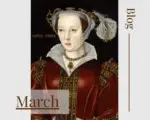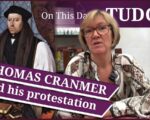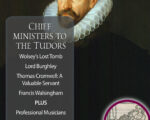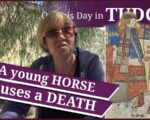
-
Blog: Parr’s Million Pound Mansion and Henry’s Regret

-
March 31 – John Donne, the bell tolls for thee and King Henry VIII as King Ahab, Anne Boleyn as Jezebel
On this day in history, 31st March 1631, the Tudor and Stuart metaphysical poet, satirist, lawyer and clergyman John Donne died.
Donne had an amazing career, going on voyages, serving as a royal chaplain and diplomat, and writing sermons, songs, satires and poetry, including an erotic poem, “The Flea”.
Find out more about John Donne and hear some of his work in this talk…
[Read More...] -
March 30 – Thomas Cranmer and his protestation, and A “pregnant” Mary I makes her will

On this day in Tudor history, 30th March 1533, at the Passion Sunday service, Thomas Cranmer, Archdeacon of Taunton, was consecrated as Archbishop of Canterbury.
His consecration was not like those of others before him, however, because as well as making the usual oath promising to be faithful to the papacy and to denounce heretics, he also made a protestation to show that his oath would not conflict with his loyalty to King Henry VIII and his commitment to reforming the church. Hmmmm…. complicated.
Find out more in this talk…
[Read More...] -
April 2022 – Chief Ministers

Who were the chief ministers in the Tudor period? What influence did they have over the people around them and the country as a whole?
[Read More...] -
March 29 – Children encourage John Laurence at his sad end and the marriage of Mary Dudley

On this day in Tudor history, 29th March 1555, in the reign of Queen Mary I, Protestant and former Dominican priest, John Laurence, was burned at the stake for heresy in Colchester.
At his burning, young children encouraged him with their prayers.
Find out more about his John Laurence’s sad end in this talk…
[Read More...] -
Update on the April edition of Tudor Life

Just to let you know that the April edition of Tudor Life Magazine will be slightly delayed. Tim has been very busy as he was away for a few days last week. He was a hero. He went to Poland to rescue a Ukrainian woman, her 13-year-old daughter and their dog, and bring them home to us in Spain. They arrived safely late on Thursday night and now we have lots to do with helping them settle and register them here. They are lovely people and we’re so very glad to be able to help them. However, it’s had a knock-on effect with work for both of us, so please forgive us if things are delayed or we don’t answer emails quickly – thank you!
Slava Ukraini!
[Read More...] -
March 28 – The birth of the amazing Raphael and the death of Anne Boleyn’s chaplain and almoner John Skip

This day in history, 28th March 1483, is one of the dates out forward as the birthdate of Raffaello Sanzio da Urbino, or Raphael as he is known, the Italian Renaissance artist and architect.
Did you know that Henry VII owned a piece of art by Raphael and that Henry VIII admired his work?
Find out a bit more about Raphael and see some of his beautiful works of art in this talk…
[Read More...] -
March 27 – Arrangements are made for Prince Arthur to marry Catherine of Aragon and Reading the Bible in church could get you into trouble

On this day in Tudor history, 27th March 1489, the Treaty of Medina del Campo was signed between England and Spain.
One part of it was the arrangement of the marriage between Arthur, Prince of Wales, and Catherine (or Catalina) of Aragon. It was signed by Spain on this day and ratified in 1490 by Henry VII.
Find out more about this treaty and the betrothal and marriages (yes, plural!) of Arthur Tudor, Prince of Wales, and Catherine of Aragon in this talk…
[Read More...] -
16th Century Ambassadors Word Search

How much do you know about the men who served the Tudor monarchs abroad as diplomats or the men who were sent to the Tudor courts from other countries?
Test your knowledge and get those little grey cells working with this fun word search puzzle.
[Read More...] -
March 26 – Robert Carey and his eventful ride to King James and the death of John Dee

On this day in history, late on 26th March 1603, two days after the death of Queen Elizabeth I, Sir Robert Carey arrived at Holyrood in Edinburgh, Scotland, to inform King James VI that Queen Elizabeth I was dead and that James was now king.
It took Carey just two days to get from London to Scotland, and he had an accident on the way, but it was all worth it. Find out about his journey and what happened in this talk…
[Read More...] -
March 25 – Margaret Clitherow, the Pearl of York, and her awful end and the start of the new calendar year in the Tudor period

On this day in Tudor history, 25th March 1586, Good Friday and also Lady Day, the Feast of the Annunciation, Catholic martyr Margaret Clitherow (née Middleton), known as “the Pearl of York”, was pressed to death at the toll-booth on Ouse Bridge in York, under 7 or 8 hundredweight. She was executed for harbouring Catholic priests.
Find out more in this talk…
[Read More...] -
Anne Boleyn by Evelyn Anthony – Lil’s Book Reviews

This week we have a review of a book from over 70 years ago, yet still available today, Anne Boleyn by Evelyn Anthony.
[Read More...] -
March 24 – Robert Rich and Penelope Devereux, an unhappy marriage and The end of Queen Elizabeth I

On this day in history, 24th March 1619, Robert Rich, 1st Earl of Warwick, Tudor nobleman and politician, died at his London home, Warwick House in Holborn. He was laid to rest at Felsted Church in Essex.
Rich was an incredibly wealthy man and a good catch for Penelope Devereux, sister of the Earl of Essex, but their marriage was unhappy and she had an affair.
Find out more about Rich and his marriage in this talk…
[Read More...] -
March 23 – The last abbey is dissolved and the Pope issued a bull proclaiming Catherine of Aragon to be England’s true queen

On this day in Tudor history, 23rd March 1540, Waltham Abbey, an Augustinian house in Essex, was surrendered to the Crown.
It was the last abbey to be dissolved in Henry VIII and Thomas Cromwell’s dissolution of the monasteries.
Find out more about this historic abbey, its origins and what’s left today, and also who profited from its lands, in this talk…
[Read More...] -
March 22 – William Bourne, his life and his submarine, and Catherine Brandon, Duchess of Suffolk, a woman with spirit

On this day in Tudor history, 22nd March 1582, gunner, mathematician and writer, William Bourne was buried at Gravesend in Kent.
This popular author, who was able to explain technical matters for the common man in his books, was also a gunner, mathematician and inventor, yet he received no university education. He also drew plans for a submarine, although he never built it.
Find out more about the fascinating William Bourne and his works in this talk…
[Read More...] -
March 21 – Elizabeth I takes to her bed and The end of Thomas Cranmer

On this day in Tudor history, 21st March 1603, a dying Queen Elizabeth I finally took to her bed.
Elizabeth I had been queen since November 1558, but now she was dying. She had deep-rooted melancholy, couldn’t sleep and was refusing to eat. She spent her days lying on cushions in her withdrawing chamber. But on 21st March, she was finally persuaded to go to bed.
Find out more about these last days in this talk…
[Read More...] -
March 20 – St Cuthbert Mayne, an Elizabethan priest and martyr, and Forgetting God to love a king – Thomas Seymour’s end

On this day in Tudor history, 20th March 1544, Cuthbert Mayne (Main/Maine) or St Cuthbert Mayne, Roman Catholic priest and martyr, was baptised in Youlston in North Devon.
Cuthbert Mayne has gone down in history as the first seminary priest to be martyred. He was hanged, drawn and quartered at Launceston on 30th November 1577, in the reign of Queen Elizabeth I.
Find out more about this Elizabethan martyr in this talk…
[Read More...] -
Tudor Elizabeths Crossword Puzzle

This week’s Sunday puzzle tests your knowledge of Tudor Elizabeths.
Elizabeth was a popular name in the 16th century, but can you remember all of these Tudor Elizabeths?
Get those little grey cells working with this fun crossword.
[Read More...] -
March 19 – Elizabeth Seymour, Lady Cromwell and Romeo and Juliet’s author dies in a shipwreck

On this day in Tudor history, 19th March 1568, Elizabeth Seymour, Lady Cromwell, died. She was around fifty years old at her death.
Elizabeth was the sister of a queen, and a lord protector, and two of her brothers were executed as traitors, but what else do we know about Elizabeth Seymour and how is she linked to the Cromwell family and a portrait once thought to be of Queen Catherine Howard?
Find out more in this talk…
[Read More...] -
March 18 – Elizabeth I is arrested and The birth of Mary Tudor, Queen of France

On this day in Tudor history, 18th March 1554, Palm Sunday, the twenty-year-old Lady Elizabeth (the future Queen Elizabeth I) was escorted by barge from her home at Whitehall Palace along the River Thames to the Tower of London, and imprisoned there.
Elizabeth had been implicated in Wyatt’s Rebellion, a rebellion that sought to depose Queen Mary I and put Elizabeth, the queen’s half-sister, on the throne in her place.
Where was Elizabeth imprisoned? What happened to her? Find out more about Elizabeth’s arrest and her time in the Tower of London in this talk…
[Read More...] -
A Tudor Springtime – Brigitte Webster

What was life like for the everyday Tudor when the seasons began to change from winter into spring? Find out all about it from Brigitte Webster in this week’s video.
[Read More...] -
March 17 – Alexander Alesius’ terrifying vision of Anne Boleyn and Elizabeth I’s famous Tide Letter

On this day in Tudor history, 17th March 1565, Scottish theologian and Reformer Alexander Alesius (also known as Ales, Aless), died in either Leipzig or Edinburgh.
Alesius wrote a huge number of theological works, was friends with reformers Philip Melancthon and Thomas Cranmer, Archbishop of Canterbury, but had a row with the Bishop of London at one point.
Find out more about Alexander Alesius and his terrifying vision or nightmare he experienced in the early hours of 19th May 1536, the day of Queen Anne Boleyn’s execution in this talk…
[Read More...] -
March 16 – Richard Burbage, actor and friend of Shakespeare and The martyrdom of two Catholic priests in York

On this day in history, 16th March 1619, actor Richard Burbage was buried at St Leonard’s Church, Shoreditch.
Burbage was a famous actor in the reigns of Queen Elizabeth I and King James I, performing for royalty and even being in King James’ company of players.
Burbage was also a good friend of William Shakespeare, and the two men were involved in the building of the famous Globe Theatre.
Find out more about Richard Burbage, his life and career, in this talk…
[Read More...] -
March 15 – Henry VIII uses foul language and The Lady Mary causes a stir in London

On this day in Tudor history, 15th March 1532, King Henry VIII used what was described as “foul language” to William Warham, Archbishop of Canterbury.
Henry VIII also threatened the poor man, and it is amazing that Warham kept his head as the king was furious.
What happened? Find out what Warham did to upset the king in this talk…
[Read More...] -
March 14 – A man who served 4 monarchs and kept his head, and A mumbling judge causes problems

On this day in Tudor history, 14th March 1555, courtier, envoy and landowner, Sir John Russell, 1st Earl of Bedford, died at his London residence on the Strand aged around 70.
Russell was an important Tudor man who served four Tudor monarchs – Henry VII, Henry VIII, Edward VI and Mary I – AND he managed to keep his head, dying a natural death at a good age.
Find out more about this Earl of Bedford, his life, his rise and his career at the royal court, in this talk…
[Read More...] -
March 13 – A young horse causes the death of an old earl and The hangings of conspirators Henry Cuffe and Sir Gelly Meyrick

On this day in Tudor history, 13th March 1540, sixty-eight-year-old Henry Bourchier, 2nd Earl of Essex, died after suffering a broken neck in a horse-riding accident. Chronicler Charles Wriothesley recorded: “the Earl of Essex, riding a young horse, by misfortune cast him and brake his neck at his place in Essex, which was great pity.”
Henry Bourchier, 2nd Earl of Essex, was related to the royal family and served both Henry VII and Henry VIII.
Find out more about this Tudor man in this talk…
[Read More...] -
Royal Relatives Word Search

This Sunday’s Tudor Society puzzle tests your knowledge of royal relatives.
How much do you know about the men and women who were related to the Tudor kings and queens?
Find out with this fun word search.
[Read More...] -
March 12 – The hidden remains of a treacherous monk and The death of Thomas Boleyn, father of Anne Boleyn

On this day in Tudor history, 12th March 1537, Cistercian monk William Haydock of Whalley Abbey, Lancashire, was hanged for treason at Whalley.
Haydock’s abbey had been implicated in the 1536 Pilgrimage of Grace Rebellion, so Henry VIII wanted the abbey punished.
Find out more about Whalley Abbey’s part in the rebellion, how Haydock and several other monks were punished, and what exactly happened to William Haydock’s remains, in this talk…
[Read More...] -
11 March – William Warner, our English Homer and The wonderful deathbed words of an Elizabethan poet

On this day in history, 11th March 1609, Tudor poet and lawyer William Warner was buried at the Church of St John the Baptist at Great Amwell in Hertfordshire.
Not many people today have heard of William Warner, but he was a well-respected and well-known poet in the Tudor era and even described as “our English Homer”. He is known for his huge poem, “Albion’s England, or, Historicall Map of the same Island”.
Find out more about this poet in this talk…
[Read More...] -
10 March – John de Vere, 13th Earl of Oxford’s role in the Wars of the Roses, and Henry VIII and a nasty jousting accident

On this day in Tudor history, 10th March 1513, magnate John de Vere, 13th Earl of Oxford, died at his home at Castle Hedingham in Essex.
Oxford was a key figure in the Wars of the Roses and played an important role in the Battle of Bosworth Field.
Find out more about his life and career and just how complicated this civil war was in this talk…
[Read More...]
